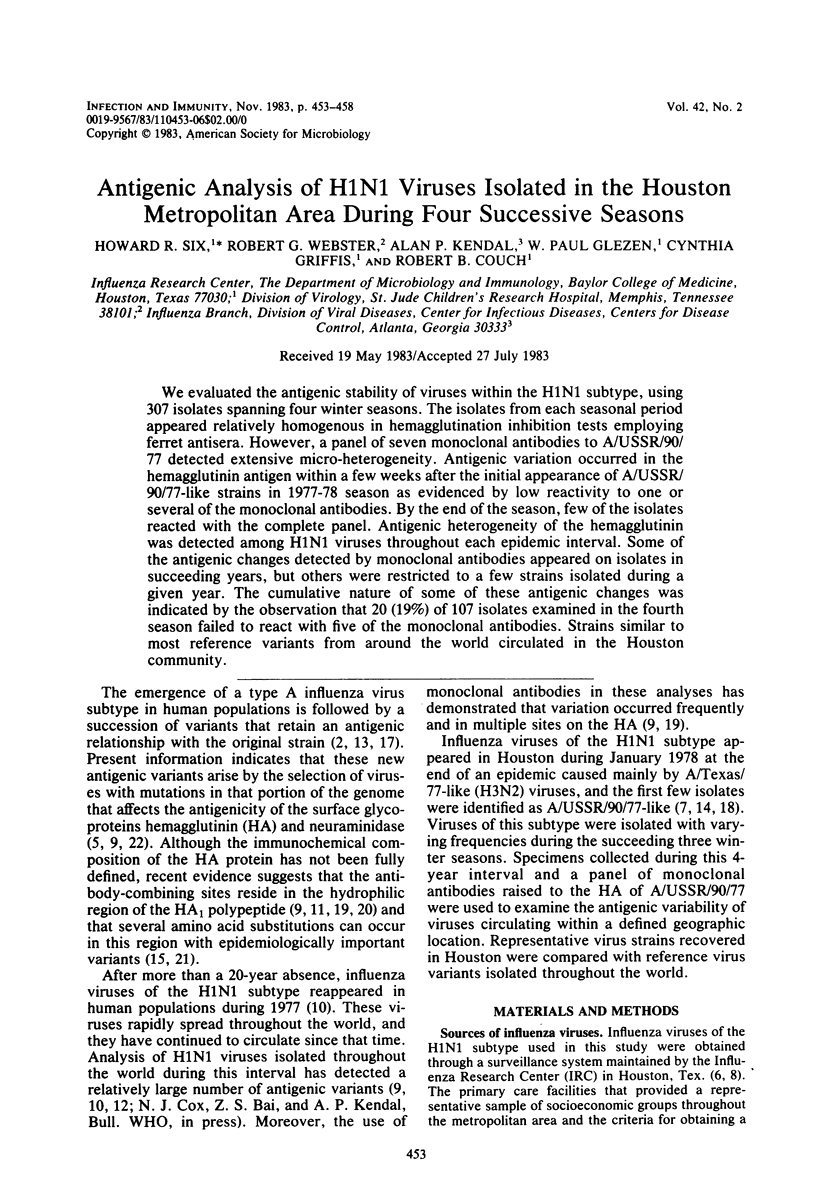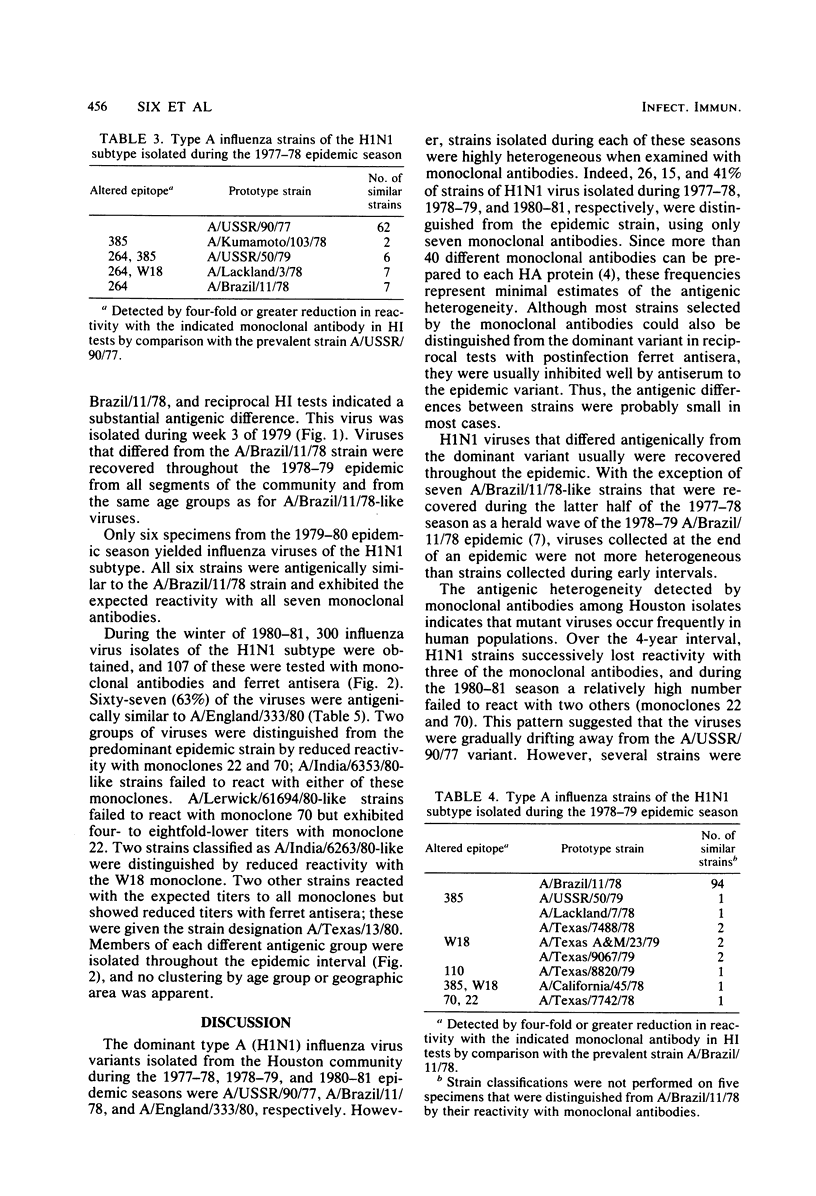Abstract
We evaluated the antigenic stability of viruses within the H1N1 subtype, using 307 isolates spanning four winter seasons. The isolates from each seasonal period appeared relatively homogenous in hemagglutination inhibition tests employing ferret antisera. However, a panel of seven monoclonal antibodies to A/USSR/90/77 detected extensive micro-heterogeneity. Antigenic variation occurred in the hemagglutinin antigen within a few weeks after the initial appearance of A/USSR/90/77-like strains in 1977-78 season as evidenced by low reactivity to one or several of the monoclonal antibodies. By the end of the season, few of the isolates reacted with the complete panel. Antigenic heterogeneity of the hemagglutinin was detected among H1N1 viruses throughout each epidemic interval. Some of the antigenic changes detected by monoclonal antibodies appeared on isolates in succeeding years, but others were restricted to a few strains isolated during a given year. The cumulative nature of some of these antigenic changes was indicated by the observation that 20 (19%) of 107 isolates examined in the fourth season failed to react with five of the monoclonal antibodies. Strains similar to most reference variants from around the world circulated in the Houston community.
Full text
PDF





Selected References
These references are in PubMed. This may not be the complete list of references from this article.
- Baxter B. D., Couch R. B., Greenberg S. B., Kasel J. A. Maintenance of viability and comparison of identification methods for influenza and other respiratory viruses of humans. J Clin Microbiol. 1977 Jul;6(1):19–22. doi: 10.1128/jcm.6.1.19-22.1977. [DOI] [PMC free article] [PubMed] [Google Scholar]
- Fazekas de St Groth, Webster R. G. Disquisitions of Original Antigenic Sin. I. Evidence in man. J Exp Med. 1966 Sep 1;124(3):331–345. doi: 10.1084/jem.124.3.331. [DOI] [PMC free article] [PubMed] [Google Scholar]
- Frank A. L., Couch R. B., Griffis C. A., Baxter B. D. Comparison of different tissue cultures for isolation and quantitation of influenza and parainfluenza viruses. J Clin Microbiol. 1979 Jul;10(1):32–36. doi: 10.1128/jcm.10.1.32-36.1979. [DOI] [PMC free article] [PubMed] [Google Scholar]
- Gerhard W., Webster R. G. Antigenic drift in influenza A viruses. I. Selection and characterization of antigenic variants of A/PR/8/34 (HON1) influenza virus with monoclonal antibodies. J Exp Med. 1978 Aug 1;148(2):383–392. doi: 10.1084/jem.148.2.383. [DOI] [PMC free article] [PubMed] [Google Scholar]
- Glezen W. P., Couch R. B. Interpandemic influenza in the Houston area, 1974-76. N Engl J Med. 1978 Mar 16;298(11):587–592. doi: 10.1056/NEJM197803162981103. [DOI] [PubMed] [Google Scholar]
- Glezen W. P., Couch R. B., Six H. R. The influenza herald wave. Am J Epidemiol. 1982 Oct;116(4):589–598. doi: 10.1093/oxfordjournals.aje.a113441. [DOI] [PubMed] [Google Scholar]
- Glezen W. P., Couch R. B., Taber L. H., Paredes A., Allison J. E., Frank A. L., Aldridge C. Epidemiologic observations of influenza B virus infections in Houston, Texas, 1976-1977. Am J Epidemiol. 1980 Jan;111(1):13–22. doi: 10.1093/oxfordjournals.aje.a112865. [DOI] [PubMed] [Google Scholar]
- Kendal A. P., Joseph J. M., Kobayashi G., Nelson D., Reyes C. R., Ross M. R., Sarandria J. L., White R., Woodall D. F., Noble G. R. Laboratory-based surveillance of influenza virus in the United States during the winter of 1977-1978. I. Periods of prevalence of H1N1 and H3N2 influenza A strains, their relative rates of isolation in different age groups, and detection of antigenic variants. Am J Epidemiol. 1979 Oct;110(4):449–461. doi: 10.1093/oxfordjournals.aje.a112826. [DOI] [PubMed] [Google Scholar]
- Lubeck M. D., Gerhard W. Topological mapping antigenic sites on the influenza A/PR/8/34 virus hemagglutinin using monoclonal antibodies. Virology. 1981 Aug;113(1):64–72. doi: 10.1016/0042-6822(81)90136-7. [DOI] [PubMed] [Google Scholar]
- Nakajima S., Cox N. J., Kendal A. P. Antigenic and genomic analyses of influenza A(H1N1) viruses from different regions of the world, February 1978 to March 1980. Infect Immun. 1981 Apr;32(1):287–294. doi: 10.1128/iai.32.1.287-294.1981. [DOI] [PMC free article] [PubMed] [Google Scholar]
- Schild G. C., Oxford J. S., Dowdle W. R., Coleman M., Pereira M. S., Chakraverty P. Antigenic variation in current influenza A viruses: evidence for a high frequency of antigenic 'drift' for the Hong Kong virus. Bull World Health Organ. 1974;51(1):1–11. [PMC free article] [PubMed] [Google Scholar]
- Velazco J. G., Couch R. B., Six H. R., Glezen W. P. Surveillance of influenza in Houston, Texas, USA: gradual transition from A/Victoria/75 (H3N2) to A/Texas/77 (H3N2) predominance and antigenic characterization of "intermediate" strains. Bull World Health Organ. 1983;61(2):345–352. [PMC free article] [PubMed] [Google Scholar]
- Webster R. G., Kendal A. P., Gerhard W. Analysis of antigenic drift in recently isolated influenza A (H1N1) viruses using monoclonal antibody preparations. Virology. 1979 Jul 15;96(1):258–264. doi: 10.1016/0042-6822(79)90189-2. [DOI] [PubMed] [Google Scholar]
- Wiley D. C., Wilson I. A., Skehel J. J. Structural identification of the antibody-binding sites of Hong Kong influenza haemagglutinin and their involvement in antigenic variation. Nature. 1981 Jan 29;289(5796):373–378. doi: 10.1038/289373a0. [DOI] [PubMed] [Google Scholar]
- Wilson I. A., Skehel J. J., Wiley D. C. Structure of the haemagglutinin membrane glycoprotein of influenza virus at 3 A resolution. Nature. 1981 Jan 29;289(5796):366–373. doi: 10.1038/289366a0. [DOI] [PubMed] [Google Scholar]
- Young J. F., Desselberger U., Palese P. Evolution of human influenza A viruses in nature: sequential mutations in the genomes of new H1N1. Cell. 1979 Sep;18(1):73–83. doi: 10.1016/0092-8674(79)90355-6. [DOI] [PubMed] [Google Scholar]
- Young J. F., Palese P. Evolution of human influenza A viruses in nature: recombination contributes to genetic variation of H1N1 strains. Proc Natl Acad Sci U S A. 1979 Dec;76(12):6547–6551. doi: 10.1073/pnas.76.12.6547. [DOI] [PMC free article] [PubMed] [Google Scholar]


